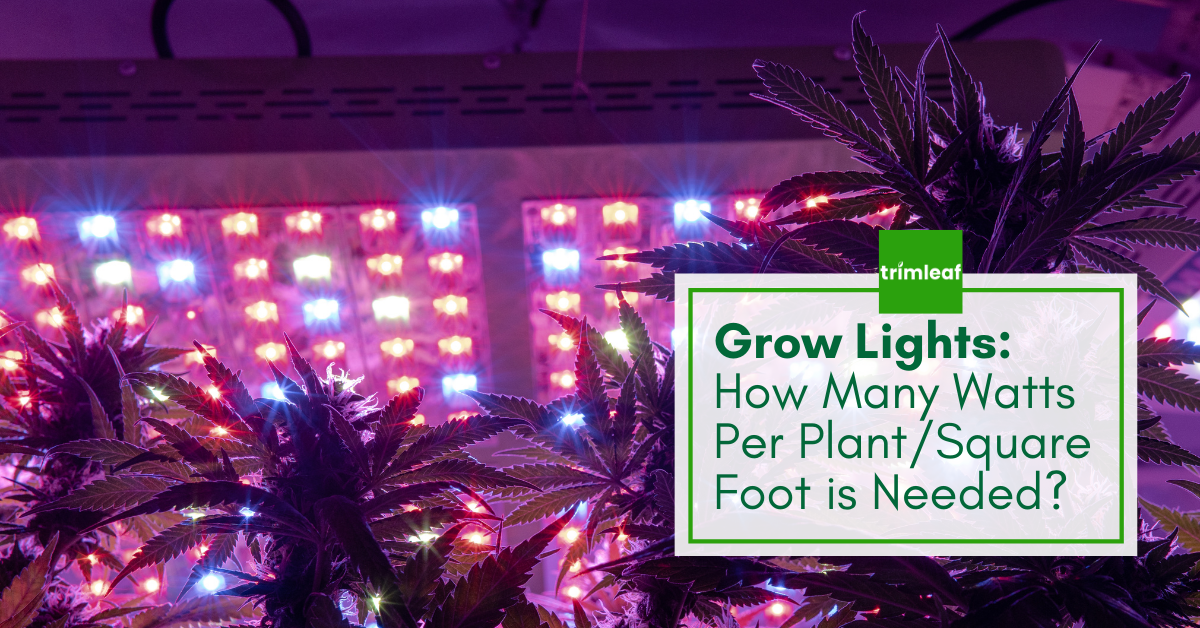
One consideration in setting up an indoor grow space, such as a
grow tent, is the number of lights you need, and with
LED Grow Lights as the way to go in indoor growing, it’s essential to know the capacity of an LED fixture for you to maximize its potential.
With
LEDs being more efficient than the traditional HPS, you can’t use the same rules in setting up an indoor space using the former, as this can damage your plants. That said, how many watts per plant do you need for LED Grow Lights?
And the answer: it depends.
Let's explore further.
Table of Contents
How Do LED Grow Lights Work?

Indoor plants can't get sunlight, so they need artificial light to grow. That's where grow lights come in. These lights give off certain types of light that plants use to make food and grow.
Various types of grow lights, such as LED, HID, and fluorescent lights, all function in a similar manner. When a grow light is switched on, it releases photons, which are tiny particles of light energy. These photons are taken in by the plant's leaves and utilized to fuel the process of photosynthesis.
Factors That Affect LED Choice

It's important to know that there are three factors that you need to consider when choosing the actual wattage of the LED Grow Lights. This includes:
Type of Plant
Plants have different lighting needs, which is why you need to know how much light a plant needs. As a rule of thumb, the higher the wattage, the more intense the light is.
Leafy plants and herbs usually need lower wattage. Fruit and flowering plants like tomatoes and cannabis need higher wattage. The amount of power you need for leafy plants would often be half of what a flower-bearing plant needs.
Total Growth Area
When it comes to the total growth space area, this pertains to how much space your plants cover and not the footprint of your space. That will help you also decide how much wattage you need for every plant.
Different growing techniques are a consideration in the total area of growth. And while that affects wattage, you can’t just split the light to get the right amount of power. Instead, you can use that light in a position that can help benefit multiple plants.
Growth Phase
The wattage of a grow light for indoor plants is a crucial factor in determining the amount of light energy it can deliver to the plants. A higher wattage results in a brighter light and more light for the plants. However, it is important to note that more wattage does not always equate to better results.
Additionally, it is important to consider that various types of grow lights differ in their ability to convert electrical energy into light energy efficiently. LED grow lights, for example, exhibit greater efficiency when compared to traditional high-pressure sodium (HPS) lights. As a result, LED lights are able to generate the same level of light output while consuming less wattage.
| Plant Growth Stage | Wattage per Square Foot | Wattage per Square Meter |
|---|---|---|
| Seedlings and Clones | 20-40 watts | 215-430 watts |
| Vegetative Growth | 40-60 watts | 430-645 watts |
| Flowering and Fruiting | 60-80+ watts | 645-860+ watts |
So, how much do you need per plant per area?
Thirty-two watts of power should be enough for every square foot as a rule of thumb. You can go a bit low to 30, but don’t go beyond 40 per square foot. So how good is a 32-watt LED?
Let’s take the Screen of Green technique as an example.

A Screen of Green requires about 0.25 square feet of grow space. With a 32-watt LED grow light, you can provide enough lighting for four plants. For a Sea of Green, the same 32-watt grow light can provide lighting for one plant.
On the other hand, 32-watts of power won’t be enough for a low-stress training, which occupies at least two square feet of grow space.
As you can see, you can use a grow light for multiple plants. But take note that it’s not ideal to do so all the time. For one, the lighting coverage on the outer part of the light’s footprint isn’t as beneficial as being close to the center. And while you can cram plants under a grow light, the results won’t be as helpful.
Sounds simple? There are some considerations to consider with the growth space and wattage. LED grow lights vary in efficiency, meaning some will use less energy to produce the same amount of light as others. This means that wattage alone is not the best indicator of how strong of a grow light you need for a specific area.
Photosynthetically Active Radiation (PAR)

Image courtesy of migrolight.com
PAR, or photosynthetically active radiation, is just as important to know when deciding how much lighting you need to grow your plants. PAR measures the intensity you need to grow your plants. To give you an idea, leafy plants need around a PAR of 200, while fruit-bearing plants would thrive between 400–500, depending on the plant.
Knowing how much PAR a grow light has will affect how a plant grows. If the PAR is too low, your plant will have a hard time growing and will probably have stunted growth. Too intense lights, meanwhile, can burn your plants. That’s why LED grow lights need to be set at an optimal height, even with the lower heat emission.
Advanced Wattage Considerations

PPFD (Photosynthetic Photon Flux Density)
PPFD is a more accurate way to measure the light intensity that plants can use for growth. Unlike PAR, which measures the overall light intensity, PPFD focuses on the specific wavelengths of light that plants can absorb for photosynthesis.
This makes PPFD a more reliable indicator of how much light your plants are actually getting. By measuring PPFD, you can ensure that your plants are receiving the optimal amount of light for their growth stage and type.
Light Spectrum
The light spectrum emitted by LED grow lights is crucial for plant growth. Different wavelengths of light have varying effects on plants.
For example, blue light promotes vegetative growth, while red light stimulates flowering and fruiting. By choosing LED grow lights with the appropriate light spectrum, you can optimize your plants' growth and development.
Dimming and Light Distribution
Dimmable LED grow lights offer flexibility in adjusting light intensity to meet the specific needs of your plants at different stages of growth. This can help prevent over-lighting or under-lighting, ensuring that your plants receive the optimal amount of light.
Proper light distribution ensures that all plants receive even coverage. Consider using reflective materials or adjusting the height and placement of your grow lights to achieve optimal light distribution.
Wrapping Up
Setting up LED grow lights in your indoor space need not be complicated. As long as you know the capacity of your grow lights, you can maximize the potential of your fixture, as well as your plants. With the proper settings, your plants can thrive to their fullest while operating at lower costs.
Learn more about LED grow lights here:
- Best LED Grow Lights (2024)
- The Best 4x4 LED Grow Lights
- LED Grow Lights: A Comprehensive Buyer's Guide
- All About Grow Lights for Indoor Plants
- Growing Indoors with LED Grow Lights? Here are 4 Things to Consider
- Pay Attention to These Things When Buying LED Grow Lights
- 5 Tips for Selecting the Best Cannabis Grow Lights
Frequently Asked Questions About Grow Lights
- What is wattage in relation to grow lights?
-
Wattage is a measure of power consumption. Higher wattage generally indicates more light output, but efficiency also plays a role.
- How does wattage affect plant growth?
-
Adequate wattage provides the necessary light intensity for photosynthesis, which is essential for plant growth and development.
- Is higher wattage always better?
-
Not necessarily. While higher wattage can provide more light, it's important to consider the specific needs of your plants and the efficiency of your grow lights.
- How do I calculate the wattage I need?
-
A general rule of thumb is to aim for 30-50 watts per square foot of grow space for LED grow lights. However, this can vary depending on factors mentioned above.
- Can I use the same wattage throughout all growth stages?
-
No, it's generally recommended to increase wattage as plants progress through different stages.
- How do I know if my plants are receiving enough light?
-
Look for signs of healthy growth, such as vibrant green leaves and strong stems. If plants appear stunted or pale, they may not be receiving enough light.
- What are the common types of grow lights?
-
LED, HID (high-intensity discharge), fluorescent, and incandescent are common types.
- Which type of grow light is most energy-efficient?
-
LED grow lights are generally the most energy-efficient option.
- What is the difference between actual wattage and advertised wattage?
-
Advertised wattage may be higher than the actual power consumption. Always check the label for the actual wattage.
- What is PAR and how does it relate to wattage?
-
PAR (Photosynthetically Active Radiation) measures the light spectrum that plants can use for photosynthesis. Higher PAR levels generally require higher wattage.
- What should I do if my plants are not growing well despite adequate wattage?
-
Consider other factors such as nutrient deficiencies, temperature, humidity, and air circulation.




